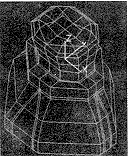 |
 |
关键词:支抗;牙应力分析;牙周组织;有限元法
摘要 目的: 分析Begg细丝技术第一期上颌支抗磨牙及其支抗组织的生物力学效应。方法: 三维有限元法,模型采用中国人上颌第一磨牙平均几何尺寸,包括516个单元。结果: 1.支抗磨牙所受的合力为伸长力,牙及牙周组织的应力分布不均匀,拉应力、压应力混合存在。2.根分叉周围是应力集中区和缓冲带。3.牙体瞬间转动中心是一个范围,位于根分叉处偏近中颊根及舌侧根区域的牙槽骨中。牙体呈现出“螺旋式”不平衡近中舌向旋转上升趋势。结论: 支抗磨牙及其牙周组织应力复杂,牙的各部分运动趋势不平衡,且提示上述结论同样适合于方丝弓技术。
The biomechanicaleffect study of maxillary anchorage molar
and its periodentium by FEM.
Peng Youjian, Cheng Xiangrong,Hu Zhiyun.
HuBei Medical University, Stomatological College & Hospital,Wuhan 430079
Abstract Objecive: This study was designedto investigate the biomechanical effect induced in maxillary first molar and itsperiodontal tissue by anchorage bend at the Begg technique stage. Methods: The three-dimensionalfinite method. The three-dimensional finite element model was constructed on the basis ofaverage anatomic morphology of the Chinese maxillary first molar, and consist of 516ispoparametric elements.Results : The stress were nonuniform, the tensilestresses and the compressive stresses existed intermingly. It was trifurcationarea thatstresses were concentrated in. The join force was an extrusion force. The center ofrotation was an area located at the alvelar bone under the trifurcation near themesiobuccal root and palatal root. The tendency of the molar movement was a spiralrotation unequivalent extrusion movement. Conclusion: The stresses werecomplicated.The tendency of the archonege molar were unequivalent. The above resultsprovided a reference for Begg technique and edgewise technique.
......
您现在查看是摘要页,全文长 17058 字符。